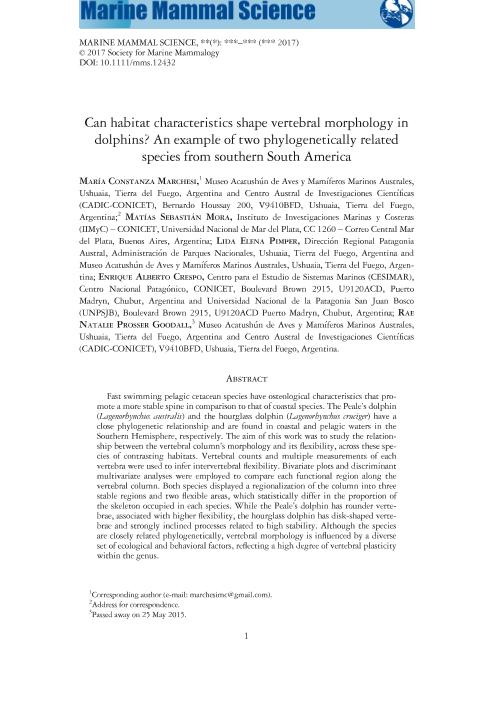Artículo
Can habitat characteristics shape vertebral morphology in dolphins? An example of two phylogenetically related species from southern South America
Marchesi, María Constanza ; Mora, Matias Sebastian
; Mora, Matias Sebastian ; Pimper, Lida Elena
; Pimper, Lida Elena ; Crespo, Enrique Alberto
; Crespo, Enrique Alberto ; Prosser Goodall, Rae Natalie
; Prosser Goodall, Rae Natalie
 ; Mora, Matias Sebastian
; Mora, Matias Sebastian ; Pimper, Lida Elena
; Pimper, Lida Elena ; Crespo, Enrique Alberto
; Crespo, Enrique Alberto ; Prosser Goodall, Rae Natalie
; Prosser Goodall, Rae Natalie
Fecha de publicación:
07/2017
Editorial:
Wiley Blackwell Publishing, Inc
Revista:
Marine Mammal Science
ISSN:
0824-0469
Idioma:
Inglés
Tipo de recurso:
Artículo publicado
Clasificación temática:
Resumen
Fast swimming pelagic cetacean species have osteological characteristics that promote a more stable spine in comparison to that of coastal species. The Peale?s dolphin (Lagenorhynchus australis) and the hourglass dolphin (Lagenorhynchus cruciger) have a close phylogenetic relationship and are found in coastal and pelagic waters in the Southern Hemisphere, respectively. The aim of this work was to study the relationship between the vertebral column?s morphology and its flexibility, across these species of contrasting habitats. Vertebral counts and multiple measurements of each vertebra were used to infer intervertebral flexibility. Bivariate plots and discriminant multivariate analyses were employed to compare each functional region along the vertebral column. Both species displayed a regionalization of the column into three stable regions and two flexible areas, which statistically differ in the proportion of the skeleton occupied in each species. While the Peale?s dolphin has rounder vertebrae, associated with higher flexibility, the hourglass dolphin has disk-shaped vertebrae and strongly inclined processes related to high stability. Although the species are closely related phylogenetically, vertebral morphology is influenced by a diverse set of ecological and behavioral factors, reflecting a high degree of vertebral plasticity within the genus.
Archivos asociados
Licencia
Identificadores
Colecciones
Articulos(CESIMAR)
Articulos de CENTRO PARA EL ESTUDIO DE SISTEMAS MARINOS
Articulos de CENTRO PARA EL ESTUDIO DE SISTEMAS MARINOS
Citación
Marchesi, María Constanza; Mora, Matias Sebastian; Pimper, Lida Elena; Crespo, Enrique Alberto; Prosser Goodall, Rae Natalie; Can habitat characteristics shape vertebral morphology in dolphins? An example of two phylogenetically related species from southern South America; Wiley Blackwell Publishing, Inc; Marine Mammal Science; 33; 4; 7-2017; 1-23
Compartir
Altmétricas



